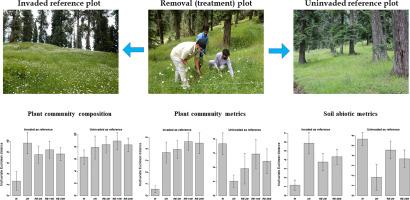Ecological Engineering ( IF 3.9 ) Pub Date : 2021-03-25 , DOI: 10.1016/j.ecoleng.2021.106219 Rameez Ahmad , Irfan Rashid , Maroof Hamid , Akhtar H. Malik , Anzar A. Khuroo

|
Recognizing the global urgency of restoring degraded ecosystems, the United Nations has proclaimed 2021–2030 as the Decade on Ecosystem Restoration. Among various global drivers of ecosystem degradation, the long-persisting impact of invasive species in the form of invasion shadow (or legacy effect) within belowground soil system, even after physical removal of plant invaders aboveground, is one of the major impediments to successful restoration. Using field manipulation experiment, we investigated the invasion shadow effects by evaluating ecological changes both in above- and belowground systems, following removal of Leucanthemum vulgare – a global plant invader – across multiple sites selected along an elevational gradient in Kashmir Himalaya. At each site, three types of plots were set up: plots invaded by L. vulgare – referred to as invaded reference, invader removal plots within the invaded area – referred to as removal plots, and spatially separated uninvaded plots outside the invaded area – referred to as uninvaded reference. The removal plots were significantly different from both invaded and uninvaded reference plots in terms of multiple biodiversity metrics. Both species richness and cover of exotic plants increased significantly in the removal plots when compared with the reference plots. However, in terms of integrated community composition metric, the removal plots differed significantly from the invaded reference plots only. Further, in terms of standard soil abiotic metrics, the removal plots were significantly different from both invaded and uninvaded reference plots, thus clearly suggesting invasion shadows. Our results reveal that, even after removal of invasive species aboveground, there are persistent invader-induced changes in soil chemistry, which impedes successful restoration of invaded ecosystem. We conclude that physical removal of invasive species aboveground alone is inadequate for restoration of invaded ecosystems, and call for additional management actions to anticipate invasion shadow effects in soil system. Building on the lessons learnt from this study, we propose a way-forward for effective management and policy interventions to guide ecological restoration of invaded ecosystems.
中文翻译:

土壤系统中的入侵阴影使被入侵的生态系统的恢复蒙上阴影:对入侵植物管理的启示
认识到恢复退化的生态系统的全球紧迫性,联合国宣布2021年至2030年为生态系统恢复十年。在各种全球生态系统退化的驱动因素中,即使在物理上清除了植物入侵者之后,地下土壤系统内以入侵阴影(或遗留效应)形式存在的入侵物种的持久影响也是成功恢复的主要障碍之一。 。通过野外操作实验,我们通过评估去除了白花菜的地下和地下系统的生态变化,研究了入侵阴影效应。–全球植物入侵者–在克什米尔喜马拉雅山沿海拔梯度选择的多个地点之间。在每个站点上,建立了三种类型的地块:被L入侵的地块。庸俗的–称为入侵参考,入侵区域内的入侵者清除图-称为清除图,以及入侵区域以外在空间上分开的未入侵图-称为未入侵参考。就多重生物多样性指标而言,清除地块与已入侵和未入侵的参考地块都存在显着差异。与参考样地相比,去除地上物种的丰富度和外来植物的覆盖率均显着增加。但是,就综合社区组成指标而言,清除地块与被入侵的参考地块仅存在显着差异。此外,就标准的非生物土壤指标而言,清除地块与已入侵和未入侵的参考地块都存在显着差异,因此清楚地表明了入侵阴影。我们的结果表明,即使去除了地上的入侵物种,入侵者仍会持续引起土壤化学变化,这阻碍了入侵生态系统的成功恢复。我们得出的结论是,仅对地上的入侵物种进行物理清除不足以恢复被入侵的生态系统,并呼吁采取其他管理措施以预测土壤系统中的入侵阴影效应。根据从本研究中获得的经验教训,我们提出了一种有效的管理和政策干预措施的方法,以指导入侵生态系统的生态恢复。并呼吁采取其他管理措施,以预测土壤系统中的入侵阴影效应。基于从这项研究中获得的经验教训,我们提出了一种有效的管理和政策干预措施的方法,以指导入侵生态系统的生态恢复。并呼吁采取其他管理措施,以预测土壤系统中的入侵阴影效应。根据从本研究中获得的经验教训,我们提出了一种有效的管理和政策干预措施的方法,以指导入侵生态系统的生态恢复。











































 京公网安备 11010802027423号
京公网安备 11010802027423号